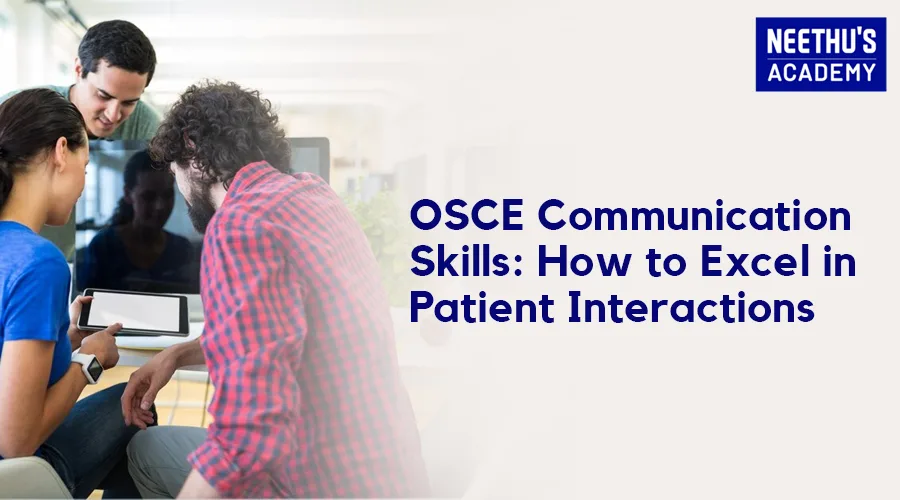OSCE Exam Pattern & Syllabus: Full Overview
Feeling a bit overwhelmed about the OSCE? You’re not alone! The Objective Structured Clinical Examination is a big step in your medical journey, and knowing what to expect can make all the difference. In this guide, we’ll break down the OSCE exam pattern and syllabus, making it easier for you to tackle this challenge with confidence. Whether you’re just starting your prep or looking for ways to refine your skills, we’ve got practical tips and insights to help you succeed. Let’s dive in and make your OSCE preparation as smooth and effective as possible!
Understanding the OSCE Exam
The OSCE is designed to simulate real clinical scenarios where candidates demonstrate their practical skills in a controlled setting. The exam assesses a range of competencies, including clinical examination, history taking, procedural skills, and communication abilities. The primary goal is to evaluate how well candidates can perform and integrate these skills in a practical context.
A typical OSCE station might involve a scenario in which the candidate must take a patient’s history and then perform a physical examination based on given symptoms. In this way, the candidates are tested not only for their knowledge but also to ensure their skills are workable in clinical settings with efficiency. It is a critical element in both medical and healthcare professional training programs, ultimately confirming that professionals are capable of meeting the very high standards expected for delivering good patient care.
OSCE Exam Structure
The OSCE exam is always divided into several stations; each station represents an aspect that will be used to determine whether the candidate possesses specific clinical skills. The exam format is usually as follows:
Clinical skills stations: It evaluates the performance of a candidate in terms of practical tasks such as physical examination, history-taking, and procedural skills. A typical example of a clinical skills station could be to ask the candidate to carry out a cardiac examination or to demonstrate how to administer an injection.
Communication Skills Stations: These test a candidate’s ability to interact with patients like explaining a procedure, delivering bad news, or providing some patient education. Communication lies at the core of delivering patient-centered care, and these stations will test whether a candidate is capable of communicating effectively and empathetically with the patient.
Decision-making stations: They assess the candidate’s ability to make appropriate clinical decisions about the given scenarios. Candidates might be presented with a clinical problem and asked to devise a management plan or even determine which of the series of activities they would perform first.
Each station is timed, usually 5-10 minutes, and candidates rotate through a series of such stations within an overall time limit. The aim is the naturalistic yet standardized assessment of a wide range of skills.
Syllabus of the OSCE Exam
The syllabus of the OSCE examination encompasses a wide range of clinical competencies and knowledge aspects. The following is a detailed outline of what this typically encompasses:
Clinical examination: It involves the techniques of undertaking thorough and systematic physical examinations across all systems: cardiovascular, respiratory, gastrointestinal, etc. The candidates must understand the standard procedures of examinations and how to interpret the findings correctly.
History taking: It is the ability to take and document detailed histories of patients. This encompasses an understanding of concerns, symptoms, and past medical history of the patients. Good history-taking enables something quite important: the formulation of a diagnosis and, subsequently, a treatment plan.
Procedural Skills: This involves practical tasks such as administering injections, taking blood samples, and performing basic life support. Proficiency in these skills is essential for daily clinical practice.
Communication Skills: The candidate should be able to explain the procedures to the patients, reassure them, and handle sensitive issues. It is necessary to have good communication so that patients can place their trust in them and understand with clarity.
Treatment Decision: This means the competence to evaluate situations clinically and come up with appropriate decisions on what should be done, plus prioritization of activities. Decision-making skills form one of the most essential facets in any clinical practice or management of patients.
The OSCE Exam: How is it done?
Station Format: Candidates pass through a sequence of stations each dealing with various skills or scenarios. While one station may require a candidate to take a complete patient history, another station might challenge a candidate’s procedural skills.
Timing: Each station is timed to ensure that candidates demonstrate their skills within a minimum amount of time. Timing becomes very critical since candidates must rush against time to finish tasks, but without sacrificing accuracy.
Scoring: Scoring is done for each station based on some sort of checklist that measures candidates’ performance in a range of areas. The scoring criteria are designed to objectively evaluate the candidate’s competence in each area.
Tips for an Effective Preparation Plan
Getting Used to the Exam Format: Familiarize yourself with the OSCE exam structure, including the types of stations you will encounter. Review the specific guidelines provided by the examination body to understand what to expect.
Practice of Clinical Skills: Develop your proficiency in regular clinical procedures and examinations. Make use of practice stations and scenarios to simulate the exam setting and to further hone your skills.
Communication Skills: Enhance your communicative skills to explain the procedures, concerns, and empathetic responses to the patients.
Practice Sample OSCE Questions: Utilize OSCE sample questions and scenarios to get a sense of the types of tasks and questions that may be included in the exam. Practice these questions to build confidence and familiarity.
Make a Study Schedule: Make a study plan that allocates time to all aspects of the syllabus, including practice and reviews. Set aims and milestones to check your progress.
Seek Feedback: Ask for feedback from tutors, fellow students, or mentors on your performance in the mock tests. Use such feedback to find the weak points to work out changes in your study schedule.
Study Materials for the OSCE Exam
Textbooks and Guides: Use comprehensive medical textbooks and OSCE preparation guides that give details of the syllabus for the OSCE exam. Recommended textbooks that should be used include those related to clinical examination, history taking, and procedural skills.
Online Resources: Access online resources and tutorials that offer practice questions, sample scenarios, and tips for the OSCE exam. Many websites and platforms provide interactive practice tools and video demonstrations.
Clinical Skills Workshops: Participate in workshops or training sessions that provide hands-on practice and feedback. Workshops offer an opportunity to practice skills in a simulated environment and receive guidance from experienced instructors.
Mock tests for OSCE
Mock tests for OSCE are the handiest resources one could have. These mock tests give an idea about what one can expect in the real exam, and you get to practice character roles in a simulated environment under timed conditions.
Simulate Exam Conditions: Take mock tests in conditions that closely mimic the actual examination setting in terms of time and station setup. This will help you get used to the format in which the examination is going to be carried out and enable you to learn how to manage your time well.
Review Performance: After completing mock tests, review your performance to identify strengths and areas for improvement. Analyze your performance based on the scoring criteria and adjust your study plan as needed.
Seek Feedback: If possible, obtain feedback from instructors or peers on your performance during mock tests. Use this feedback to enhance your preparation and address any weaknesses.
Final Thoughts
Preparing for the OSCE can feel like a daunting task, but with the right approach and resources, you can walk into the exam room with confidence. Remember, the OSCE is your opportunity to showcase the skills you’ve worked so hard to develop. By understanding the exam pattern, studying the syllabus, and practicing with mock tests, you’ll be well on your way to success.
Take it one step at a time, stay focused, and believe in your abilities. You’ve got this! As you continue your preparation, keep in mind that every bit of effort you put in now will pay off when it matters most. Good luck on your OSCE journey!
Frequently Asked Questions





